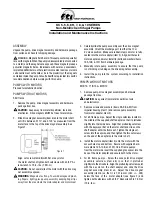
3 - 4
Cavro® XLP 6000 Modular Syringe Pump Operating Manual, 734237-C, en
3 - Software Communication
Communication Protocols
OEM Protocol Command Block Characters
The command block characters in the OEM communication protocol are
described below. All characters outside the command block are ignored.
When developing a parsing algorithm, the programmer should key on the STX as
the beginning of the answer block and the checksum (character after the ETX) as
the end of the answer block.
STX (^B or 02h)
The STX character indicates the beginning of a command
Pump Address
The pump address is a hexadecimal number specific for each pump.
Sequence Number/Repeat Flag
The sequence number is a single byte that conveys both a sequence number
(legal values: 0 to 7) and a bit-flag indicating that the command block is being
repeated due to a communications breakdown. The sequence number is used
as an identity stamp for each command block. Since it is only necessary that
every message carry a different sequence number from the previous
message (except when repeated), the sequence number may be toggled
between two different values (e.g., “1” and “2”) as each command block is
constructed. During normal communication exchanges, the sequence number
is ignored. If, however, the repeat flag is set, the pump compares the
sequence number with that of the previously received command block to
determine if the command should be executed or merely acknowledged
without executing.
Note: If the operator chooses not to use this option, the sequence number can be
set to a fixed value of 1 (31h).
4+n
ETX (^C or 03h)
5+n
Checksum
Answer Block
(see “OEM Protocol Answer Block Characters” for details)
1
STX (^B or 02h)
2
Master address (0 or 30h)
3
Status code
3+n
Data block (length n)
4+n
ETX (^C or 03h)
5+n
Checksum
















































